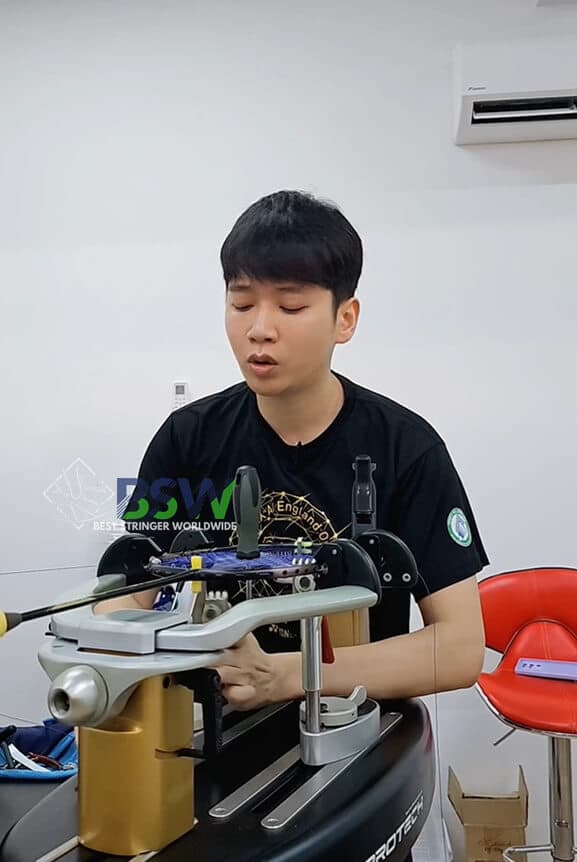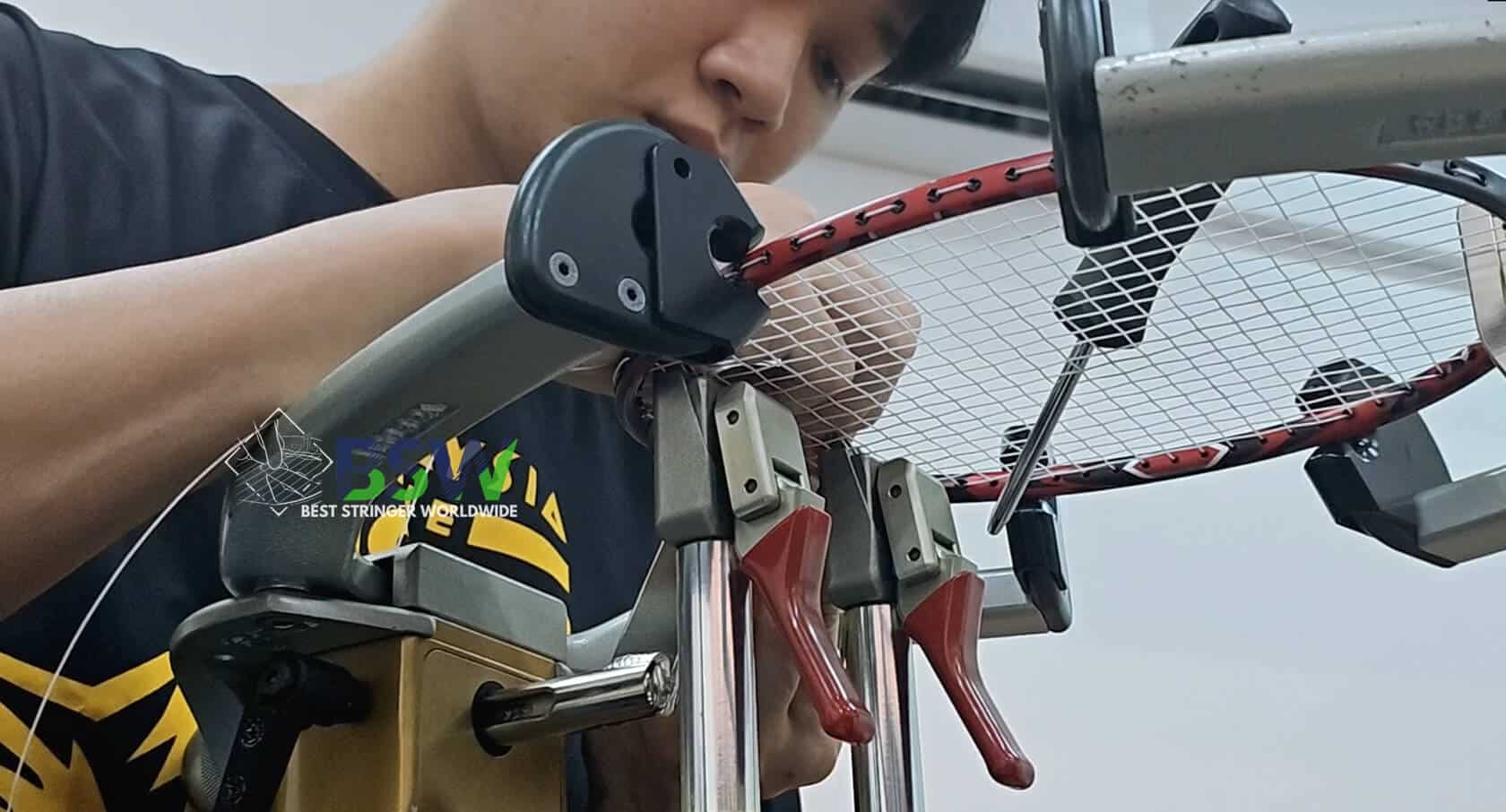In the world of tennis, racquet stringing is both an art and a science. At Best Stringer Worldwide (BSW), we’ve created this comprehensive guide to help stringers and players understand the complex factors that influence string bed stiffness. When discussing stringing tension with customers, we’re actually talking about the overall stiffness of the string bed.
The string bed, also known as the racquet face, refers to the surface created by all the strings within the racquet frame. It’s the only part of the racquet that makes contact with the ball during play, and it’s responsible for transmitting the feel of the shot to the player. Understanding string bed stiffness is crucial for optimizing racquet performance and player comfort.
String Bed Stiffness Simulator
Estimated String Bed Stiffness:
Moderate Stiffness
The Importance of String Bed Stiffness
String bed stiffness affects various aspects of a player's game, including:
- Power generation
- Control
- Spin potential
- Comfort and shock absorption
- Overall feel of the racquet
While players often focus solely on string tension, it's essential to understand that tension is just one of several factors influencing the overall feel and performance of the string bed. Let's dive into the seven key factors that determine string bed stiffness.
1. Racquet Face Size (String Length)
The size of the racquet face significantly impacts string bed stiffness, although players may not always be aware of this. Larger racquet faces require longer strings, which in turn affects the overall stiffness of the string bed.
According to research by Dr. Howard Brody, to achieve the same string bed stiffness across different racquet sizes, the ratio of string tension to string length must remain relatively constant. For example:
- A 93 square inch racquet with a main string length of about 31 cm strung at 60 pounds
- A 110 square inch racquet with a main string length of about 34 cm would need to be strung at approximately 66 pounds to achieve the same string bed stiffness
If both racquets were strung at 60 pounds, the 110 square inch racquet would have only 91% of the string bed stiffness of the 93 square inch racquet.
This knowledge is crucial when helping customers transition between racquet sizes. If a player switches from a mid-size to an oversize racquet and requests the same 60-pound tension, it's important to explain the need for increased tension to maintain a similar feel.
| Racquet Size (sq in) | Typical Main String Length (cm) | Recommended Tension Range (lbs) | Tension Adjustment* |
|---|---|---|---|
| 85-90 | 29-30 | 50-65 | -5% |
| 95-100 | 31-32 | 55-70 | Baseline |
| 105-110 | 33-34 | 58-73 | +5% |
| 115-120 | 35-36 | 60-75 | +8% |
| 125+ | 37+ | 62-77 | +10% |
* Tension adjustment is relative to a baseline 95-100 sq in racquet. Adjust tension accordingly when changing racquet sizes to maintain similar string bed stiffness.
2. String Pattern (String Bed Density)
The string pattern, or string bed density, refers to the number of main (vertical) and cross (horizontal) strings in the racquet face. Common patterns include 16x19, 18x20, and others.
String pattern affects string bed stiffness in several ways:
- Denser patterns (e.g., 18x20) generally result in higher string bed stiffness
- More open patterns (e.g., 16x19) typically have lower string bed stiffness
Manufacturers design string patterns to achieve specific goals:
- Increased durability: Larger racquet faces often use denser patterns to improve string longevity
- Enhanced control: Some patterns are designed to increase control for specific playing styles
- Spin generation: More open patterns can increase spin potential by allowing more string movement
The choice of string pattern can significantly impact a player's performance:
- Topspin players often prefer more open patterns for increased spin generation
- Flat hitters may benefit from denser patterns for improved control
It's important to note that more open patterns may lead to reduced string durability due to increased friction and movement between strings.

3. String Type
The material and construction of the string play a crucial role in determining string bed stiffness. Strings with higher elasticity generally result in lower string bed stiffness. Common string materials include:
- Natural Gut: Highly elastic, offering excellent feel and comfort
- Nylon (Synthetic Gut): Good balance of performance and affordability
- Polyester: Low elasticity, popular for spin and control
- Kevlar and Aramid fibers: Very stiff, often used for durability
When recommending strings, consider the following:
- Kevlar and aramid strings typically require lower tension (about 10% less) to achieve a similar feel to other materials
- Multifilament strings aim to mimic the properties of natural gut
- Hybrid setups combining different string types can offer a balance of performance characteristics
4. String Gauge (Thickness)
String gauge, or thickness, has a subtle but noticeable effect on string bed stiffness. Contrary to what many players expect, thinner strings often result in slightly lower string bed stiffness due to their increased elasticity.
Key points about string gauge:
- Thinner strings (higher gauge numbers) generally offer more feel and spin potential
- Thicker strings (lower gauge numbers) typically provide more durability
- The difference in string bed stiffness between gauges is relatively small but can be noticeable to experienced players
[Interactive String Gauge Comparison Tool placeholder]
5. Stringing Tension
Perhaps the most obvious factor affecting string bed stiffness is the tension at which the strings are installed. Higher tension results in greater string bed stiffness, while lower tension creates a softer, more forgiving string bed.
Important considerations for tension:
- Tension affects power, control, and comfort
- Lower tension generally offers more power and comfort but may reduce control
- Higher tension typically provides more control but can decrease power and comfort
- The "sweet spot" for tension varies depending on the player's style, skill level, and preferences
6. Stringing Machine Type
The type of stringing machine used can significantly impact the resulting string bed stiffness. There are two main types of stringing machines:
- Lock-out machines (manual, spring-based systems)
- Constant-pull machines (electronic or drop-weight systems)
Constant-pull machines typically produce a tighter string bed compared to lock-out machines at the same nominal tension. The difference can be as much as 10% in string bed stiffness.
When using a constant-pull machine, consider reducing the tension by 5-10% compared to what you would use on a lock-out machine to achieve a similar feel.
7. Stringer's Technique
The skill and technique of the stringer play a crucial role in determining the final string bed stiffness. Various factors in the stringing process can affect the outcome:
- Clamping distance
- Pre-stretching techniques
- Single vs. double-pull methods
- Weaving techniques
- Tensioning speed and consistency
Experienced stringers develop consistent techniques that produce reliable results. However, even among skilled professionals, there can be slight variations in the final string bed stiffness due to individual techniques.
Professional String Bed Stiffness Quiz
Conclusion
Understanding the seven factors that determine string bed stiffness is crucial for both stringers and players. By considering these elements, stringers can provide more accurate and personalized recommendations to their clients. Players, in turn, can make more informed decisions about their equipment and better communicate their preferences to stringers.
At Best Stringer Worldwide (BSW), we're committed to advancing the knowledge and skills of tennis enthusiasts and professionals alike. Whether you're looking to optimize your own racquet setup or provide better service to your clients, understanding string bed stiffness is an invaluable skill.
For those interested in deepening their knowledge and skills in tennis racquet stringing, consider enrolling in a comprehensive tennis racquet stringing course. BSW offers professional tennis stringing certification programs that cover all aspects of racquet customization, including the nuances of string bed stiffness.
Remember, the perfect string bed setup is a personal choice that varies from player to player. By understanding these factors, you can experiment with different combinations to find the ideal setup that enhances your game and playing experience.
String Gauge Comparison Tool
Comparison Results
| Property | Gauge 1 | Gauge 2 |
|---|---|---|
| Durability | ||
| Spin Potential | ||
| Feel |

About Best Stringer Worldwide
Best Stringer Worldwide is a comprehensive badminton and tennis stringing education program. We provide in-depth training on stringing techniques, racquet technology, and player-specific customization. Our curriculum is designed to help stringers understand and meet the needs of all badminton players, from casual enthusiasts to competitive athletes.
Read More